» posted on Friday, November 22nd, 2013 by Linda Lou Burton
Getting To Goal
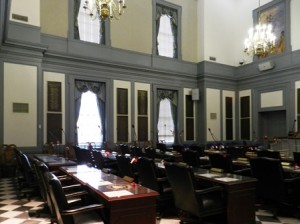 Linda Burton posting from Dover, Delaware – Of course I was bragging. “This is my 49th capitol,” I said to Nathaniel and Michael, as we began our tour of Leg Hall. “Leg Hall” is the affectionate nickname for the Delaware state capitol, because it’s where the legislature has met since 1933. It’s a stately Georgian brick structure, in keeping with the history of the town; located in First State Heritage Park along with the Old State House and the Golden
Linda Burton posting from Dover, Delaware – Of course I was bragging. “This is my 49th capitol,” I said to Nathaniel and Michael, as we began our tour of Leg Hall. “Leg Hall” is the affectionate nickname for the Delaware state capitol, because it’s where the legislature has met since 1933. It’s a stately Georgian brick structure, in keeping with the history of the town; located in First State Heritage Park along with the Old State House and the Golden 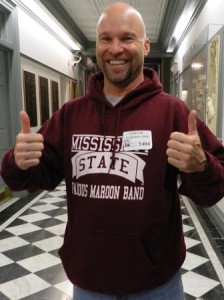 Fleece Tavern, all part of a complex of state buildings and historic moments. I was reveling in my own “historic moment” as I continued my boast; “49th out of 50! Only one to go and that’s Annapolis. I’m getting close!” Both men nodded in approval, affirming they were impressed with my achievement. “Nice!” said Michael, who was visiting from Texas. “I’ve got twelve left to see myself. But, I have run a marathon in all 50 states.” Well now, that was a topper. “Picture time,” I said, grinning. “This is a thumbs-up photo op. I’ve never met anyone who has
Fleece Tavern, all part of a complex of state buildings and historic moments. I was reveling in my own “historic moment” as I continued my boast; “49th out of 50! Only one to go and that’s Annapolis. I’m getting close!” Both men nodded in approval, affirming they were impressed with my achievement. “Nice!” said Michael, who was visiting from Texas. “I’ve got twelve left to see myself. But, I have run a marathon in all 50 states.” Well now, that was a topper. “Picture time,” I said, grinning. “This is a thumbs-up photo op. I’ve never met anyone who has 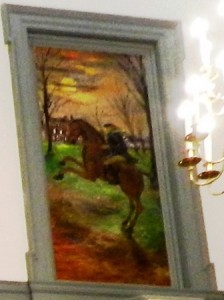 run 50 marathons, much less in every state!” Michael posed for me, thumbs appropriately up. It’s interesting what people do, and how much effort they’ll put forth to achieve a goal. Tour guide Nathaniel led us into the Senate Chambers then, slipping into storytelling mode as he pointed to the murals above our heads, and told the tales of Delaware. They were people stories, of course; it’s people who had the vision, and the goals; it’s people who did what it took. Nathaniel pointed to the mural of a man on a horse; the sky had an eerie darkening cast; the trees were bare. Hurry! The horse reared up, the man’s scarf flew behind. “That is Caesar Rodney,” he began.
run 50 marathons, much less in every state!” Michael posed for me, thumbs appropriately up. It’s interesting what people do, and how much effort they’ll put forth to achieve a goal. Tour guide Nathaniel led us into the Senate Chambers then, slipping into storytelling mode as he pointed to the murals above our heads, and told the tales of Delaware. They were people stories, of course; it’s people who had the vision, and the goals; it’s people who did what it took. Nathaniel pointed to the mural of a man on a horse; the sky had an eerie darkening cast; the trees were bare. Hurry! The horse reared up, the man’s scarf flew behind. “That is Caesar Rodney,” he began.
I leaned forward in my chair as Nathaniel described Caesar Rodney’s ride; I could see his mud-flicked face as he traveled through thunder and rain from his farm in Kent County to Philadelphia; I could feel the urgency. It was a desperate moment, the two delegates already in Philadelphia were deadlocked; the call had come for the tie-breaking vote. Did Delaware favor independence from British rule? Caesar Rodney wasn’t well; he suffered from asthma; his face was disfigured by cancer. But when word came that his vote was crucial, he jumped to 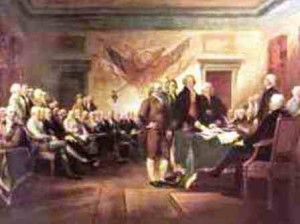 his horse and rode through the night; he rode until his horse could run no more; he stopped at taverns, or farms, to switch mounts, he kept going. It usually took three days to get to Philadelphia; Caesar Rodney got there in fifteen hours.
his horse and rode through the night; he rode until his horse could run no more; he stopped at taverns, or farms, to switch mounts, he kept going. It usually took three days to get to Philadelphia; Caesar Rodney got there in fifteen hours.
The men meeting as the Second Continental Congress in Philadelphia were wanted for treason; since the events at Lexington and Concord in 1775, the professional imperial army had attempted to arrest patriot leaders. The Olive Branch Petition was sent to King George in hopes of peaceful resolution, but he refused, declaring the colonies to be in a state of rebellion. He sent Hessian mercenaries to bring things under control; the moderate voices were dealt a blow and cries for independence grew stronger.
The Continental Congress felt they’d reached the point of no return; it was time to bring it to a vote. One of the Delaware delegates, George Read, cast his vote NO; the other, Thomas McKean, voted YES; the Delaware delegation was deadlocked. That’s when the message was sent to the third delegate, Caesar Rodney, to come despite his illness, and break the tie. 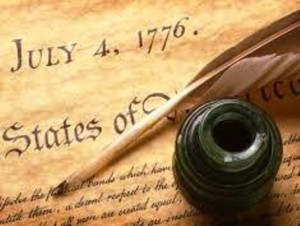 Imagine this facially disfigured man entering Independence Hall, out of breath from the ride and likely wheezing from his asthma as well; mud-caked and wet, but determined. The sight of him prompted Read to change his vote; Delaware unanimously stood up for independence. Caesar Rodney became one of the 56 signers of the Declaration of Independence that day; yes, July 4, 1776.
Imagine this facially disfigured man entering Independence Hall, out of breath from the ride and likely wheezing from his asthma as well; mud-caked and wet, but determined. The sight of him prompted Read to change his vote; Delaware unanimously stood up for independence. Caesar Rodney became one of the 56 signers of the Declaration of Independence that day; yes, July 4, 1776.
“My goodness!” I said, taking a deep breath. “That was an exciting story. I’ve never heard of Caesar Rodney. Longfellow didn’t immortalize him in a poem, like Paul Revere!” “Yes, sometimes people think that mural is of the Headless Horseman,” Nathaniel laughed, “but Caesar Rodney is a hero to Delaware.”
The Leg Hall murals were done by Jack Lewis (1912-2012) in 1987, to commemorate the 200th anniversary of the United States Constitution. Delaware is proud of its distinction as the “First State,” having been first to ratify the Constitution on December 7, 1787. The ten murals are acrylic on Masonite, and grace both the Senate and House chambers. Study the murals for a while and you have a good idea of Delaware history. (Yes, I noticed a bit of artistic license regarding the Rodney mural; the trees would not have been bare in July, I thought; but it conveys quite well the idea of overcoming obstacles in order to reach a goal.)
Senate Murals
- Barratt’s Chapel. Methodism in America began in Barratt’s Chapel in November 1784 when John Wesley, an ordained Methodist minister, first administered the sacraments to Delaware faithful.
 The Pilots of Lewes. Ocean sailing ships arriving in Lewes needed the help of expert pilots to navigate the shoals and rock of Delaware Bay, so shallow-draft pilot boats brought them in.
The Pilots of Lewes. Ocean sailing ships arriving in Lewes needed the help of expert pilots to navigate the shoals and rock of Delaware Bay, so shallow-draft pilot boats brought them in.- The Dickinson Plantation. John Dickinson was one of the framers of the US Constitution. His country home was built in 1740; it burned in 1804 but was restored as part of the 18th century farm.
- Ratification of the Constitution by Delaware. Thirty Delaware delegates, ten from each county, met in Battell’s tavern (aka The Golden Fleece) on December 7, 1787. There they voted quickly and unanimously to ratify and confirm the Constitution, making Delaware the First State.
- Caesar Rodney’s Ride. In July 1776 Caesar Rodney made the most famous ride in Delaware history, traveling to Philadelphia to cast his vote for independence. The three Delaware delegates then signed the Declaration of Independence.
House Murals
- The Landing of the Swedes. The first Swedish colonists in America landed on the banks of the Christina River March 29, 1638. Leader Peter Minuit purchased land from the Lenni Lenapi Indians, established trade, and constructed Fort Christina.
- George Washington at New Castle. General George Washington attended a wedding in the Amstel House in New Castle on April 30, 1784, where he stood on the hearthstone and kissed the pretty girls, “as was his wont.”
- Old Swedes Church, Wilmington. The cornerstone for Old Swedes Church was laid May 28, 1698; the Lutheran pastor was Eric Bjork. The building has been in continual use since 1699; it is now an Episcopal Church.
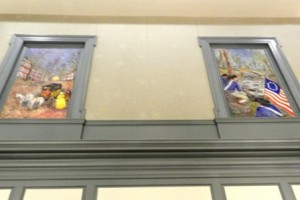 The New Castle Strand. The street nearest the river in New Castle is lined with picturesque Georgian houses; one is the George Read house built in 1797. Packet Alley is reportedly the pathway William Penn took on his 1682 arrival in the colonies.
The New Castle Strand. The street nearest the river in New Castle is lined with picturesque Georgian houses; one is the George Read house built in 1797. Packet Alley is reportedly the pathway William Penn took on his 1682 arrival in the colonies.- The Battle of Cooch’s Bridge. September 3, 1777 was Delaware’s only Revolutionary War battle; British troops landed in Maryland and headed for Philadelphia; they skirmished with sharpshooters from Washington’s army.
We finished our tour and said our goodbyes; I picked up a stack of literature for later  study. “Be sure to visit the Old State House,” Nathaniel advised. “It served as the capitol for 141 years before this one was built. It’s just across The Green.” I gave one last admiring glance around the lobby; the walls a dignified gray-blue; the floors distinctive in black and white; “graceful” is the word I’d use to describe the look. Outside, I stopped for some shots; I liked the look of it; handmade brick topped off with a white wooden cupola, and that topped by a weathervane. Across the street in one direction, a creek curved through the trees; on the other side lay the
study. “Be sure to visit the Old State House,” Nathaniel advised. “It served as the capitol for 141 years before this one was built. It’s just across The Green.” I gave one last admiring glance around the lobby; the walls a dignified gray-blue; the floors distinctive in black and white; “graceful” is the word I’d use to describe the look. Outside, I stopped for some shots; I liked the look of it; handmade brick topped off with a white wooden cupola, and that topped by a weathervane. Across the street in one direction, a creek curved through the trees; on the other side lay the  wide expanse of Legislative Mall, and then The Green, Dover’s Public Square. There was more to tour – the John Bell House, Dover’s oldest surviving frame building; the Old State House; the Golden Fleece. Ghosts are waiting with stories to tell; stories of dreams, and goals; stories of getting there.
wide expanse of Legislative Mall, and then The Green, Dover’s Public Square. There was more to tour – the John Bell House, Dover’s oldest surviving frame building; the Old State House; the Golden Fleece. Ghosts are waiting with stories to tell; stories of dreams, and goals; stories of getting there.
About Caesar Rodney (1728-1784). Caesar Rodney was born on his family’s 800-acre farm, Byfield, on St Jones Neck in East Dover in October 1728, son of Caesar and Elizabeth Crawford Rodney. He was tutored by his parents and may have attended a local Parson’s school, but received no formal education. He was 17 when his father died and he was placed in the guardianship of Nicholas Ridgely, a clerk of the peace in Kent County; this likely was the beginning of his life in politics. He was commissioned High Sheriff in 1755; in succeeding years his duties grew to include registrar of wills, recorder of deeds, clerk of orphan’s court, and justice of the peace. At age thirty he was elected as a representative in the colonial legislature at Newcastle.
Caesar Rodney was a leading patriot in his colony; a military leader in the colonial militia, and a delegate to the Continental Congress. He was President of the State of Delaware for a three year term, and Major-General of the Delaware Militia. He played a crucial part not only in the defense of his own colony but in support of Washington’s Continental Army. Rodney saw his colony through the war at the cost of personal neglect; he never received proper treatment for his asthma and the cancerous growth on his face. He died in office June 26, 1784 while serving as Speaker to the Upper House of the Delaware Assembly, and was buried in the cemetery at Christ Church in Dover.
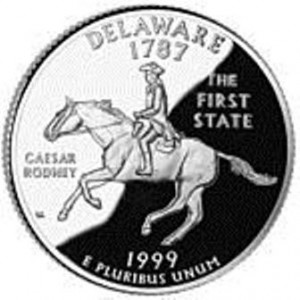 Although not (yet) immortalized in poetry, Caesar Rodney is honored by the Lewis mural in the capitol; the silver image of Caesar Rodney on horseback is etched on the Delaware quarter. You’ll find his signature on the Declaration of Independence to the right and a bit below John Hancock’s.
Although not (yet) immortalized in poetry, Caesar Rodney is honored by the Lewis mural in the capitol; the silver image of Caesar Rodney on horseback is etched on the Delaware quarter. You’ll find his signature on the Declaration of Independence to the right and a bit below John Hancock’s.
